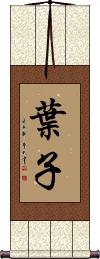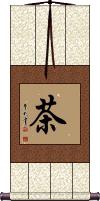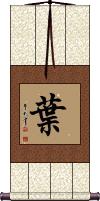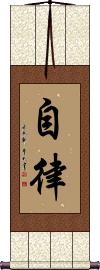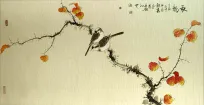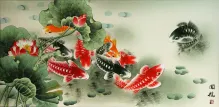Many custom options...
And formats...

The name Leaf in Chinese / Japanese...
Buy a Leaf calligraphy wall scroll here!
Personalize your custom “Leaf” project by clicking the button next to your favorite “Leaf” title below...
Leaf
茶 means tea. It can refer to prepared tea (ready-to-drink) or dry tea leaves.
The origin of tea is China but the same character is used in Japanese Kanji, and old Korean Hanja with the exact same meaning. Japanese and Korean even borrowed the pronunciation from Chinese (pronounced “cha” in all three languages).
It's said that an early doctor (or herbologist) in ancient China kept poisoning himself as he tried different new herb concoctions. He invented tea as a means to detoxify himself as he recovered from 1 of the 76 times he nearly poisoned himself to death. Tea is seen not just as a drink but as a form of medicine used to remove impurities from the body.
The word “chai” (used in many languages to refer to various teas) is derived from this Chinese word.
茶 also means camellia, as Asian teas are often based on the leaves of camellia plant varieties.
Yeh
Surname
葉 is the surname Yeh which is common in Taiwan.
The meaning of this character is harmony, leaf, page, lobe, or (historical) period. The context in which this character is used determines the meaning.
Determination to Achieve
一念発起 is a Japanese proverb, “Ichinen Hokki,” which suggests being resolved to do something or having a wholehearted intention to accomplish something.
Some will translate this as “the determination to accomplish something,” or “turning over a new leaf and being determined to find success.”
Self-Discipline / Will-Power
自律 means self-discipline and self-control.
It is doing what you really want to do rather than being tossed around by your feelings like a leaf in the wind. You act instead of reacting. You get things done in an orderly and efficient way. With self-discipline, you take charge of yourself.
Not sure if this one works for a Japanese audience.
See Also: Discipline | Self-Control
Camellia
カメリア is the name Camellia in Japanese.
This sounds like Camellia, but does not mean the camellia plant or leaf.
Instead of these characters, you may want to go with the name of the plant. Of course, camellia also means tea, as varieties of camellia plants provide the leaves for many kinds of Chinese and Japanese teas.
Note: Because this title is entirely Japanese Katakana, it should be written by a Japanese calligrapher.
This in-stock artwork might be what you are looking for, and ships right away...
These search terms might be related to Leaf:
Listen to Both Sides and Be Enlightened, Listen to One Side and Be in the Dark
Not the results for Leaf that you were looking for?
Below are some entries from our dictionary that may match your Leaf search...
| Characters If shown, 2nd row is Simp. Chinese |
Pronunciation Romanization |
Simple Dictionary Definition |
艾 see styles |
yì yi4 i mogusa もぐさ |
More info & calligraphy: Yai(1) (See 灸) moxa (dried mugwort leaf used in moxibustion); (2) (See ヨモギ・1) Japanese mugwort (Artemisia princeps); (surname) Yomogi |
葉 叶 see styles |
yè ye4 yeh you / yo よう |
More info & calligraphy: Yeh(suf,ctr) (1) counter for leaves, pieces of paper, etc.; (suf,ctr) (2) (archaism) counter for boats; (female given name) Yō; (surname) Yō; Ye pattra; parṇa; leaf, leaves. |
葉子 叶子 see styles |
yè zi ye4 zi5 yeh tzu youko / yoko ようこ |
More info & calligraphy: Leaf(female given name) Yōko |
扇 see styles |
shàn shan4 shan ougi(p); oogi(ik) / ogi(p); oogi(ik) おうぎ(P); おおぎ(ik) |
fan; sliding, hinged or detachable flat part of something; classifier for doors, windows etc folding fan; (female given name) Sen Fan; door-leaf; translit. ś, ṣ. |
扉 see styles |
fēi fei1 fei tobira とびら |
door with only one leaf (1) door; gate; opening; (2) title page |
柄 see styles |
bǐng bing3 ping tsuka つか |
handle or shaft (of an axe etc); (of a flower, leaf or fruit) stem; something that affords an advantage to an opponent; classifier for knives or blades hilt (of a sword); haft (of a dagger); handle; handgrip; (personal name) Fukumasu A handle; authority, power. |
箔 see styles |
bó bo2 po haku はく |
plaited matting (of rushes, bamboo etc); silkworm basket; metal foil; foil paper (1) foil; (gold, etc.) leaf; (2) prestige |
篇 see styles |
piān pian1 p`ien pien hin へん |
sheet; piece of writing; bound set of bamboo slips used for record keeping (old); classifier for written items: chapter, article (n,n-suf) (1) compilation (of a text); editing; (n,n-suf,ctr) (2) volume (of a text); (3) completed literary work A slip of bamboo, a slip, leaf, page, books. |
纓 缨 see styles |
yīng ying1 ying ei / e えい |
tassel; something shaped like a tassel (e.g. a leaf etc); ribbon (1) tail (of a traditional Japanese cap); (2) chinstrap; (given name) Yon |
苴 see styles |
jū ju1 chü kaishiki かいしき |
(hemp); sack cloth leaf, branch with leaves, or paper placed under a serving dish or offering |
葯 药 see styles |
yào yao4 yao yaku やく |
leaf of the iris; variant of 藥|药[yao4] {bot} anther |
袴 裤 see styles |
kù ku4 k`u ku hakama はかま |
variant of 褲|裤[ku4] (1) hakama; pleated skirt or loose-legged trousers worn over a kimono mainly on ceremonial occasions; (2) (leaf) sheath; (3) (sake bottle) stand; (surname) Hakama |
頁 页 see styles |
yè ye4 yeh peeji ページ |
page; leaf (n,ctr) (1) (kana only) page; (suffix noun) (2) (kana only) nth page; page ...; (personal name) Fukuma |
バネ see styles |
pane パネ |
(kana only) spring (e.g. coil, leaf); mainspring; power spring; (personal name) Pane |
一丁 see styles |
icchou / iccho いっちょう |
(1) one sheet; one page; one leaf; (2) one block of tofu; one serving (in a restaurant); (3) (also written as 一挺, 一梃) one long and narrow thing (e.g. guns, scissors, spades, hoes, inksticks, palanquins, candles, jinrikishas, shamisen, oars, etc.); (4) one chō (unit of distance, 109.09 m); (5) one game; one task; (n,adv) (6) well then; come then |
一葉 一叶 see styles |
yī shě yi1 she3 i she ichiyou; hitoha / ichiyo; hitoha いちよう; ひとは |
(1) one leaf; (2) (いちよう only) one page; one sheet; one card; one photo; (3) (archaism) one boat; (female given name) Hitoha A leaf; a palm-leaf or page of a sūtra. |
七節 see styles |
nanafushi ななふし |
(kana only) walking stick (any insect of order Phasmatodea); walkingstick; stick insect; leaf insect |
主脈 see styles |
shumyaku しゅみゃく |
(1) main mountain range; (2) {med} midrib; costa; (3) {bot} main vein (leaf) |
九品 see styles |
jiǔ pǐn jiu3 pin3 chiu p`in chiu pin kuhon; kokonoshina くほん; ここのしな |
(1) (abbreviation) {Buddh} (See 浄土・1) nine levels of Amitabha's Pure Land; (2) (くほん only) (See 九品浄土) Amitabha's Pure Land; (3) (くほん only) (See 九品蓮台) nine-tiered lotus leaf platform in Amitabha's Pure Land; (given name) Kuhon Nine classes, or grades, i.e. 上上, 上中, 上下 upper superior, middle superior, lower superior, and so on with 中 and 下. They are applied in many ways, e.g. 上品上生 the highest type of incarnate being, to 下品下生, the lowest, with corresponding karma; see 九品淨土. Each grade may also be subdivided into nine, thus making a list of eighty-one grades, with similar further subdivision ad infinitum. |
乾葉 干叶 see styles |
gān yè gan1 ye4 kan yeh hiba ひば |
dried leaf dried leaves; dried daikon leaves |
互生 see styles |
hù shēng hu4 sheng1 hu sheng gosei / gose ごせい |
alternate leaf arrangement (botany) (n,vs,vi) {bot} alternation (in phyllotaxis); alternate arrangement |
側脈 see styles |
sokumyaku そくみゃく |
{bot} lateral vein (in leaf venation) |
全縁 see styles |
zenen ぜんえん |
{bot} entire margin (of a leaf); leaf edge without serrations or bumps |
劍山 剑山 see styles |
jiàn shān jian4 shan1 chien shan kensan |
劍樹地獄 Asipattra. The hill of swords, or sword-leaf trees hell, one of the sixteen hells; also called 刀刃路. |
包葉 see styles |
houyou / hoyo ほうよう |
bract (leaf) |
十心 see styles |
shí xīn shi2 xin1 shih hsin jisshin |
The ten kinds of heart or mind; there are three groups. One is from the 止觀 4, minds ignorant and dark; affected by evil companions; not following the good; doing evil in thought, word, deed; spreading evil abroad; unceasingly wicked; secret sin; open crime; utterly shameless; denying cause and effect (retribution)―all such must remain in the flow 流 of reincarnation. The second group (from the same book) is the 逆流 the mind striving against the stream of perpetual reincarnation; it shows itself in devout faith, shame (for sin), fear (of wrong-doing), repentance and confession, reform, bodhi (i.e. the bodhisattva mind), doing good, maintaining the right law, thinking on all the Buddhas, meditation on the void (or, the unreality of sin). The third is the 眞言 group from the 大日經疏 3; the "seed" heart (i.e. the original good desire), the sprout (under Buddhist religious influence), the bud, leaf, flower, fruit, its serviceableness; the child-heart, the discriminating heart, the heart of settled judgment (or resolve). |
千枚 see styles |
senmai; senmai せんまい; センマイ |
(1) (せんまい only) 1000 sheets (of paper); many pages; (2) (kana only) {food} book tripe; bible tripe; leaf tripe; beef omasum; cow omasum; cow psalterium |
単葉 see styles |
tanyou / tanyo たんよう |
(1) {bot} (See 複葉・1) simple leaf; unifoliate leaf; (2) (See 複葉・2) monoplane (aircraft) |
古葉 see styles |
furuba; furuha ふるば; ふるは |
(archaism) old leaf; old leaves; (surname) Koba |
多羅 多罗 see styles |
duō luó duo1 luo2 to lo tara たら |
(1) (abbreviation) (See 多羅樹) palmyra; (2) (abbreviation) (See 多羅葉) lusterleaf holly; (3) patra (silver incense dish placed in front of a Buddhist statue); (surname, female given name) Tara tārā, in the sense of starry, or scintillation; Tāla, for the fan-palm; Tara, from 'to pass over', a ferry, etc. Tārā, starry, piercing, the eye, the pupil; the last two are both Sanskrit and Chinese definitions; it is a term applied to certain female deities and has been adopted especially by Tibetan Buddhism for certain devīs of the Tantric school. The origin of the term is also ascribed to tar meaning 'to cross', i. e. she who aids to cross the sea of mortality. Getty, 19-27. The Chinese derivation is the eye; the tara devīs; either as śakti or independent, are little known outside Lamaism. Tāla is the palmyra, or fan-palm, whose leaves are used for writing and known as 具多 Pei-to, pattra. The tree is described as 70 or 80 feet high, with fruit like yellow rice-seeds; the borassus eabelliformis; a measure of 70 feet. Taras, from to cross over, also means a ferry, and a bank, or the other shore. Also 呾囉. |
Click here for more Leaf results from our dictionary
The following table may be helpful for those studying Chinese or Japanese...
| Title | Characters | Romaji (Romanized Japanese) | Various forms of Romanized Chinese | |
| Leaf | 葉子 叶子 | kyouko / kyoko | yè zi / ye4 zi / ye zi / yezi | yeh tzu / yehtzu |
| Tea | 茶 | cha | chá / cha2 / cha | ch`a / cha |
| Yeh | 葉 叶 | you / yo | yè / ye4 / ye | yeh |
| Determination to Achieve | 一念発起 | ichi nen ho kki ichinenhokki ichi nen ho ki | ||
| Self-Discipline Will-Power | 自律 | jiritsu | zì lǜ / zi4 lv4 / zi lv / zilv | tzu lü / tzulü |
| Camellia | カメリア | kameria | ||
| In some entries above you will see that characters have different versions above and below a line. In these cases, the characters above the line are Traditional Chinese, while the ones below are Simplified Chinese. | ||||
Successful Chinese Character and Japanese Kanji calligraphy searches within the last few hours...
